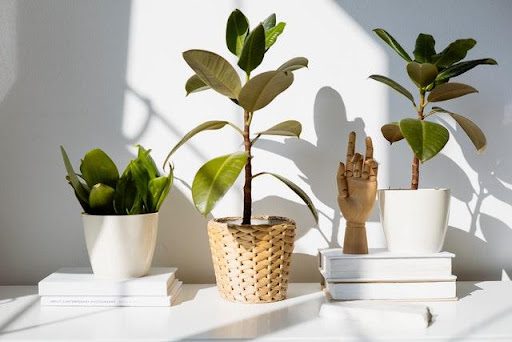As houses become more energy efficient, they circulate less air with the outdoors. We used to call that “leaking air”, as if it were a bad thing. But the downside of energy efficient houses is indoor air pollution.
Can plants help keep your indoor air cleaner? Yes, they can! As allergy season (hopefully) wains and air conditioning season approaches, I invited Elizabeth Shields to write about which plants you may want in your home to reduce indoor air pollution. This is her second publication here. Her first was about mold. If you think she should be a regular columnist here, let us know.
 According to the Environmental Protection Agency (EPA), indoor air quality at home can actually be worse than outdoors in large, highly urbanized cities. And no matter how thoroughly you do your home spring cleaning every year, you’ll probably still be exposed to toxins leaching from common chemical-based stuff, like commercial detergents, varnishes, floor finishes, carpets, and cleaning products.
According to the Environmental Protection Agency (EPA), indoor air quality at home can actually be worse than outdoors in large, highly urbanized cities. And no matter how thoroughly you do your home spring cleaning every year, you’ll probably still be exposed to toxins leaching from common chemical-based stuff, like commercial detergents, varnishes, floor finishes, carpets, and cleaning products.
Fortunately, there’s a simple and effective solution for this. Beyond aesthetic qualities, having indoor plants at home also has another significant benefit. They are natural air purifiers that actively clean the air you breathe from toxins, molds, and other irritants. This article shares our top picks for the best air-purifying indoor plants to have at home and plant care tips to help them thrive.
Peace Lily
Botanical name: Spathiphyllum’ Mauna Loa’
The peace lily is a favorite among plant lovers because it’s a flowering plant with a low-maintenance nature. It’s an excellent choice as an indoor plant because, aside from being decorative, it can also purify indoor air from harmful pollutants, such as formaldehyde, benzene, carbon monoxide, and ammonia. Keep your peace lily out of direct sunlight and water only when the topsoil is dry. Also, it’s best to put it out of reach of curious kids and pets because it’s mildly toxic when swallowed.
Snake Plant
 Botanical name: Sansevieria trifasciata ‘Laurentii’
Botanical name: Sansevieria trifasciata ‘Laurentii’
Also called the mother-in-law’s tongue, the snake plant is very robust and resilient. It’s perfect for busy homeowners because it can survive with little natural light and limited watering. Aside from its sculptural beauty, which would look good when placed in corners around the home, the snake plant also has air purifying qualities against benzene and xylene.
Chinese Evergreen
Botanical name: Aglaonema modestum
The Chinese evergreen is another air-purifying indoor plant you’ll love to have in your apartment. It comes in many colorful varieties and is relatively easy to take care of. If you believe in feng shui, the Chinese evergreen is known to be a luck-bringing ornamental plant.
However, if you have a pet at home, you might want to check out other items on this list as it contains an irritant that may harm your fur babies.
Spider Plant
Botanical name: Chlorophytum comosum ‘Vittatum’
Based on the NASA study, the spider plants were the best, stripping off 95% of toxic substances, like formaldehyde, in sealed plexiglass for 24 hours.
Spider plants are versatile because you can grow them in hanging baskets or pots placed on elevated positions, like a coffee table or window, and have the shoots trail beautifully. Like other indoor plants, they do well in bright, indirect sunlight. However, avoid overwatering them because that’ll make the soil soggy and potentially lead to root rot.
Rubber Tree
Botanical name: Ficus elastica
 Rubber trees are these gorgeous indoor plants with broad, glossy foliage that can go from green to burgundy. They take in the carbon dioxide we exhale and produce oxygen while also breaking down air toxins, mold spores, and harmful bacteria in the indoor air by 65%. Rubber trees can grow up to 6 or 10 feet tall when there’s sufficient space to accommodate them, although you can always prune them to your liking.
Rubber trees are these gorgeous indoor plants with broad, glossy foliage that can go from green to burgundy. They take in the carbon dioxide we exhale and produce oxygen while also breaking down air toxins, mold spores, and harmful bacteria in the indoor air by 65%. Rubber trees can grow up to 6 or 10 feet tall when there’s sufficient space to accommodate them, although you can always prune them to your liking.

Leave A Comment